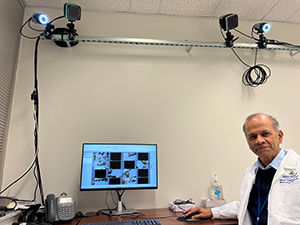2024 Edwin Land Medal Winner
Get Involved
Rama Chellappa Named the 2024 Edwin H. Land Medal Recipient
Optica and the Society for Imaging Science and Technology (IS&T) are pleased to announce that Rama Chellappa, Johns Hopkins  University (JHU), USA, has been selected as the 2024 Edwin H. Land Medal winner. Chellappa is honored for seminal contributions to the theory and practice of image/video processing and computer vision arenas resulting in inventions, technologies, and systems that have improved the lives of many worldwide. Chellappa is a visionary leader, outstanding teacher and mentor, and one of the most prolific scientists of his generation. He is pushing the boundaries of image processing, solving problems, and making a lasting impact on the field.
University (JHU), USA, has been selected as the 2024 Edwin H. Land Medal winner. Chellappa is honored for seminal contributions to the theory and practice of image/video processing and computer vision arenas resulting in inventions, technologies, and systems that have improved the lives of many worldwide. Chellappa is a visionary leader, outstanding teacher and mentor, and one of the most prolific scientists of his generation. He is pushing the boundaries of image processing, solving problems, and making a lasting impact on the field.
Chellappa received his PhD from Purdue University, USA. He is currently a Bloomberg Distinguished Professor in the Departments of Electrical and Computer Engineering (Whiting School of Engineering) and Biomedical Engineering (School of Medicine) with a secondary appointment in the Department of Computer Science at JHU. At JHU, he is currently the interim co-director of the Data Science and AI Institute and is also affiliated with the Center for Imaging Science (CIS), Center for Language and Speech Processing (CLSP), the Institute for Assured Autonomy (IAA), and the Mathematical Institute for Data Science (MINDS). He also holds a non-tenure position as a College Park Professor in the ECE department at the University of Maryland (UMD). His current research interests are artificial intelligence, computer vision, machine intelligence and signal and image processing.
He served as the Editor-in-Chief of PAMI (IEEE Transactions on Pattern Analysis and Machine Intelligence), a Golden Core Member of the IEEE Computer Society, a Distinguished Lecturer of the IEEE Signal Processing Society, and was the President of the IEEE Biometrics Council. He also co-organized two incubators for Optica.
the IEEE Computer Society, a Distinguished Lecturer of the IEEE Signal Processing Society, and was the President of the IEEE Biometrics Council. He also co-organized two incubators for Optica.
Chellappa has received many recognitions for research, teaching, innovation, and mentoring of undergraduate students, including the K. S. Fu Prize, IEEE Jack S. Kilby Signal Processing Medal, the Washington Academy of Sciences Distinguished Researcher Award, IBM Faculty Development Awards, the IEEE Biometrics Council inaugural Leadership Award. He was inducted into the National Academy of Engineering and holds nine patents. He is a Fellow of Optica, IEEE, Association for the Advancement of Artificial Intelligence, American Association for the Advancement of Science, Association for Computing Machinery, American Institute for Medical and Biological Engineering, International Association for Pattern Recognition, National Academy of Inventors and the Washington Academy of Sciences.
Established in 1992, the Edwin H. Land Medal recognizes pioneering work empowered by scientific research to create inventions, technologies and products. It honors Edwin H. Land for his unique career as scientist, technologist, industrialist, humanist and public servant. The medal is jointly presented by Optica and IS&T, and funded through the support of the Polaroid Foundation, the Polaroid Retirees Association and individual contributors, including Manfred Heiting, Theodore Voss and John J. McCann.
About Optica
Optica, Advancing Optics and Photonics Worldwide, is the society dedicated to promoting the generation, application, archiving and dissemination of knowledge in the field. Founded in 1916, it is the leading organization for scientists, engineers, business professionals, students and others interested in the science of light. Optica’s renowned publications, meetings, online resources and in-person activities fuel discoveries, shape real-life applications and accelerate scientific, technical and educational achievement.
About IS&T
The Society for Imaging Science and Technology (IS&T) is an international professional non-profit dedicated to keeping members and other imaging professionals apprised of the latest developments in the field through conferences, educational programs, publications, and its website. IS&T programs encompass all aspects of the imaging workflow, which moves from capture (sensors, cameras) through imaging processing (image quality, color, and materialization) to hard and soft copy output (printing, displays, image permanence), and includes aspects related to human vision, such as image quality and color. The Society also focuses on a wide range of image-related applications, including security, virtual reality, machine vision, and data analysis.
